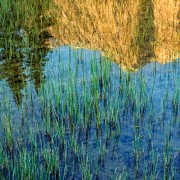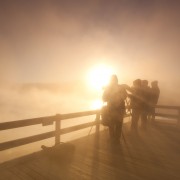Planning your next Landscape Photography Trip

I saw this waterfall marked on a map of Vermont so we stopped to see it, not knowing what to expect. It turned out to be a good stop for photography.
For many landscape photographers, travel is an essential part of creating photos. Whether you are heading to a nearby park for a long weekend or heading out on an extended international trip, spending some time on planning is always a good investment. Below, I share a few strategies I use to plan my photography-related trips, ranging from studying maps for potential opportunities to making sure I have the right resources at hand once I am visiting a place.
Before doing so, however, I want to note that I find it helpful to strike a good balance between having a plan and being open to serendipity. Being too rigid and arriving in a place with a lot of expectations can be a barrier to creative photography. As we sometimes see when teaching workshops, a photographer might plan an entire trip around a single photo they saw online or arrive with the goal of taking certain kinds of photographs. Then, when conditions do not cooperate, a photographer can be disappointed and possibly miss excellent photo opportunities in the process. Thus, for my own travel, I want to have some solid resources and a general plan but also want to stay completely open to unforeseen opportunities.

Tracking the tide levels was important in getting this photo (this beach is inaccessible much of the year due to tide levels). A tide app was very helpful in knowing when to be at this beach for photography.
Consult a Range of Sources
Our next photo trip is to Grand Teton National Park in Wyoming, a place I haven’t visited for many years. In preparing for this trip, I plan to consult a photography location guide ebook, paperback hiking guides, a hiking map for the park, and online resources. For online resources, I typically consult Facebook pages and websites of organizations based in the place I am visiting or travel/hiking-related websites. Some photographers would also add Google Earth to this list since it can be a great resource when planning a specific photograph or getting to know a spot in advance.
Photography guides are often an excellent place to start. The author typically provides much of the information a photographer needs to get to spots with high potential for both iconic and more original photography. Hiking guides, maps, and online research can be helpful in finding places that might have high potential as well but are lesser known to photographers. By consulting a range of sources, I am able to come up with some ideas about how I might want to spend my time.

By studying the map of the hiking route to this spot, we knew it had a lot of small tarns to explore. Although I had never seen photos of this specific area, I could tell from the map that it held potential for landscape photography. Jasper National Park, Canada.
Be Prepared with the Right Resources
In addition to the information sources I discuss above, I also use a variety of apps and bookmarked websites on my phone to help make the most out of a trip. Here are a few examples:
- Tide app or tide tables if I will be visiting a coastal location (along with research in advance to know which tide stations are around the area I will be visiting).
- GPS coordinates for specific spots I want to visit for scouting, with the coordinates entered into my hiking GPS. (I currently use the Gaia GPS app on my iPhone, which is the best and most affordable GPS solution I have used for hiking.)
- Bookmarks for local weather on my phone (both the NOAA weather graphs and a weather app)
- Saved locations in an app like the Photographer’s Ephemeris, which is helpful for planning around sunrise and sunset times.
- Aurora prediction websites if the possibility of photographing the aurora is present.
Some of these resources, like sunrise/sunset apps, can be helpful in both making initial plans for a trip and for use while traveling. Using my trip to the Tetons as an example, it is very helpful to know in planning the trip that sunrise can often be the best time for photography in the park and that sunrise is very early in the summer. Thus, we can select a campsite closer to the places we want to photograph so that getting up for sunrise is less of a slog each morning.

Aurora prediction sites on the internet are an important resource for landscape photographers. Knowing there was a good aurora forecast for this evening, we were able to drive to a location with clear skies.
Get the Timing Right
While I believe that is it possible to make a compelling photograph in almost any kind of conditions, optimal timing is important in landscape photography. For timing, photographers often think of seasons the prime consideration, which is often the case. I also think of another sort of timing, especially when visiting places in the winter. For example, when visiting a place like Iceland, it is important to think about the time of year when planning your itinerary. In the summer, the sun barely sets so each day is literally filled with daylight. During the winter, some days only have a few hours of daylight which can be limiting for photography. Thus, knowing how much daylight you will have when visiting a place like Iceland is a key piece of information for itinerary planning and maximizing photography opportunities.

Taking this photo required standing in the cold Virgin River in Zion National Park. Having my fishing waders along made this a much more comfortable process – I could focus on my photography, not being cold.
Bring the Right Gear
Having the right gear can make the difference between a miserable trip and an enjoyable, successful experience in nature. Many years ago, my first backpacking trip in Rocky Mountain National Park taught me this lesson in the worst way. It was late October and I didn’t have a sleeping pad. As a typically cold person, this oversight meant two uncomfortable nights in the wilderness. I also wore cotton socks and ill-fitting boots. By the end of the trip, my socks were soaked with blood from the blisters on my ankles and toes.
While this is an extreme example, it makes my point well: having the right gear can be essential to the success of a trip. We have a master packing list in Excel that is organized by the type of trip (tent camping, traveling in our RV, flying and renting a car, etc) and by season. The list includes travel items, camera gear, and outdoor gear. Although it took some time to create, this sheet means that we are almost always prepared for the weather and photography conditions we encounter and can thus make the most of our time in nature.

When we left our campsite on this morning, the sky was completely clear. We trusted the forecast, which predicted a significant increase in clouds right around sunrise.
How do you plan your photography trips?
With resources on hand and key information at my fingertips, I feel better equipped to take advantage of photographic opportunities while traveling. I do not let this research dominate my thinking or drive an inflexible plan but instead use it to help me make better decisions and get the most of out of my time in visiting a place, both new and familiar.
If you have any tips to add to this list, please share them in the comments.







 Grant Collier
Grant Collier

Very nice. Are you going to share your checklists?